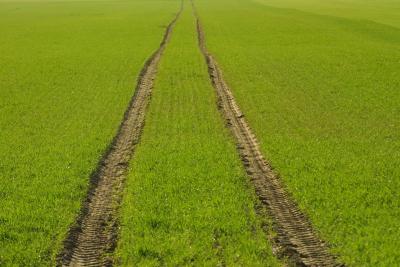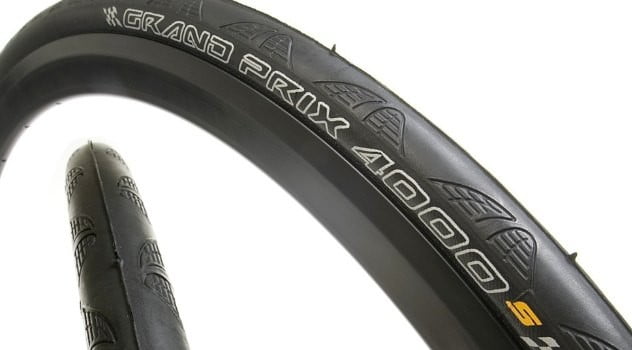Many cyclists have doubts when it comes to slick tyres and their grip, especially on wet pavement. This post will address slick bicycle tyres, their strengths and weaknesses.
1. Role of tread pattern on bicycle tyres
The tread pattern on car tyres has two roles. First, it aids traction on soft surfaces, where a tyre can dig in more easily. The other role is on hard pavement when there is rain and water on it. However, for bicycle tyres, tread pattern has use only in off-road conditions (or in the snow), none on paved roads. It will be explained why.
1.1. Off-road conditions
If the surface is soft enough for the tyre to leave an impression in it, then the tread pattern helps the tyre dig in and improves traction. A deep, aggressive tread pattern is good for mud/snow, with grooves wide enough for dirt to fall out of them, not to get stuck and fill the grooves, so that the tread pattern gets nullified.

This is why for riding on packed dirt roads, small tread pattern tyres can be useful. For riding in softer mud, snow and grass – wide knobby tyres grip best.
1.2. Paved roads
On the other hand, if the tyres don’t leave impression in the surface, for example on concrete, or pavement, the tread pattern gives no benefit to traction – quite the contrary. However uneven the pavement, tread pattern does not dig into it (rubber is softer than concrete), so it can not aid in traction. Tread pattern will seldom align with road irregularities. That is why on pavement slick tyre is the best – to make the contact patch as wide as possible, making it even, following road irregularities as good as possible.
2. Wet pavement with puddles
2.1. A few words about car tyres
Tread on a car tyre has an important role when riding on wet pavement – it enables water to be pushed out, so that rubber can reach the pavement, this helps avoid so called aquaplaining, or hydroplaning. Car tyres have a wide flat profile, so without tread pattern grooves, water would not be dispersed easily.

2.2. Difference between car and bicycle tyres
How much does a bicycle tyre differ from a car tyre? Drastically. In terms of width, as well as in terms of profile shape. Car tyre is wide and flat, while bicycle tyre is narrow and rounded:



Bicycle tyre, because of relatively small width and because of rounded profile that is perfect for pushing water aside, “slicing” through puddles, can hardly come into a situation to aquaplane. In order to do so, a cyclist must go faster than around 150 km/h.
Since a bicycle can not aquaplane (not at speeds below 100 km/h), and since the pavement doesn’t become softer when wet, tread pattern on road/city bicycles do more harm than good. Slick tyres are by far the best choice for cycling on paved roads – whether it’s sunny or rainy.
3. Slick tyres even in the rain?!
People are used to car tyres with tread, so it is hard for them to accept the fact that bicycle is not the same and the best tyres for cycling on pavement are slick. For off road riding, tread pattern is good, there is no doubt about that. However, on pavement, tread pattern does in fact lessen the traction!
To prove this it is enough to make an experiment: take a bike with fat knobby tyres and try hard braking or sharp cornering on pavement (at one’s own risk – a fall is very likely to happen). The same with slick tyres is a lot easier – grip is a lot better – this can also be easily tested. On wet pavement, the difference is even greater – the slick tyres outperform knobby ones by a higher margin, which can also be tested using the same experiment. Bending of knobs/tread, squirming, can often cause unpredictable loss of traction.
Tyres with less aggressive tread pattern are not as bad as knobbies, but slick tyres grip better than those also – just the difference is not that obviously big.

A slick tyre with a soft rubber compound that grips well is the best choice for riding on pavement.
4. Why do tyre manufacturers put grooves even on tyres designed for pavement?
Because it’s easier to just sell a tyre to people, than to try explaining that all they thought about tyres is wrong when it comes to pavement and bicycles.
Road tyres are often made with just a slight “hint” of a tread pattern, just so that customers can sleep better. 🙂

Note that the middle part that comes in contact with the pavement is totally tread-free – 100% slick.
The rest is marketing, more than function
5. Recapitulation
Slick tyres with soft, “sticky” compound are the best choice for cycling on paved roads. Especially when it is cold and rainy.
All other things being equal, tyres with tread roll slower and grip worse than their slick counterparts. More details about rolling resistance is given in this post: Are narrower tyres “faster” – rolling resistance.
Author’s recommendation for good quality, slick all-weather tyres. Clicking on the image below leads to the Amazon on-line shopping. As an Amazon Associate I earn from qualifying purchases.

Last updated:
Originally published:

Would you know if Schwalbe Kojak has a soft compound and if there is a tyre that would be fast and light as Kojak but decipitate water so that my bottom and frame is not wet when roads are wet? (I do not cycle in rain, but roads are often wet here) Thanks!
Schwalbe Kojak has a good, rather soft, grippy compound.
Schwalbe Marathon Racer, though a bit more expensive, with some minimal amount of tread, seems to be a bit faster rolling, and grips just as good. Probably more supple sidewalls.
No tyre will prevent the bottom of the frame from getting wet in the rain. Mudguards (fenders) can do that. Full length ones especially.
Something like this for 28″ wheels (622-28 to 622-37):
SKS P45 Longboard Mudguards
Or for MTB 26″ wheels (559-1.6 to 559-2.1):
SKS P55 Longboard Mudguards
There are cheaper ones and you can customize a shorter one to go all the way, or get a cheap old rear one, cut it just a bit shorter and mount it up front, where the length is most important for frame and rider protection.
Something like this is the goal:
https://farm4.staticflickr.com/3177/5873901870_a39bee43b4.jpg
Very informative
i find 700×25 road tyres a nice ride,slick tyres also run better,i buy my tyres in the 215 gram to 240 gram range,any lighter then 215 grams you are basically getting a race tyre with not the greatest puncture protection,any heavier than 240 grams you get a tyre that has very good puntcture protection but not a very smooth ride,tires with tpi 120 to 180 are very nice rolling ones with a reasonable puncture protection,continental,michelin,and pirelli are doing nice tyres,i am using pirelli p zero velo 4s at the moment and they are a very smooth rolling supple tyre,very good wet weather grip,you can buy tyres that dont get any punctures but those tyres are alot heavier and the ride is not as smooth as the lighter ones
just got a spare set of continental tyres 700×25 tube type clinchers,conti grand prix,another nice rolling smooth tyre,very supple like the pirelli ones,the conti grand prix ones have a slighty thinner sidewall but but pretty much the same amout of tread rubber,there is another good bicycle forum to look at its an australian bicycle site,bikeforums.net.au
the better link for the australian bike forum is https://www.bicycles.net.au then you arrive at bikeforums.net.au i dont know why its set up like that
Don’t get me wrong but Please explain why the author recommends the most treaded Grand Prix tyre, the 4 season model, after just explaining treads are useless and only for marketing….
Hi Trilo,
That’s a logical question. The answer is:
THe tyre’s compound, casing quality, puncture protection and price make it perform well. Overall it’s a good tyre that grips nicely in the wet and cold too.
It would have been better without any treads in my opinion. Having said that, the treads are still pretty shallow and more on the “cosmetic side” (I suppose it’s easier to sell a “good-grip-in-the-rain-tyre with some tread, than it is to explain how treads are in fact detrimental for grip on paved roads with bicycle tyres).
Relja